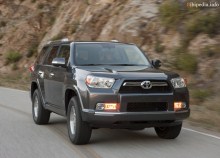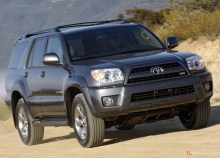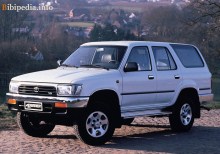Characteristics of Toyota 4Runner
Specifications Toyota 4Runner: power, fuel consumption per 100 km, weight (weight), road clearance (clearance), radius of turn, type of transmission and brakes, body sizes and tires.
Characteristics 4Runner since 2009
| Modification |
Power, kW (hp) / about |
Fuel consumption (medium), l / 100 km |
Weight (weight), kg |
| 2.7 4x2. |
117(157)/5200 |
11.8 |
1948 |
| 4,0 V6 4x2 |
201(270)/5600 |
12.4 |
1996 |
| 4,0 V6 4x4. |
201(270)/5600 |
12.4 |
2121 |
Characteristics 4Runner 2003 - 2009
| Modification |
Power, kW (hp) / about |
Fuel consumption (medium), l / 100 km |
Weight (weight), kg |
| 4,0 V6. |
176(236)/5200 |
12.2 |
1835 |
Characteristics 4Runner 1990 - 1993
| Modification |
Power, kW (hp) / about |
Fuel consumption (medium), l / 100 km |
Weight (weight), kg |
| 2.4 TD. |
66(90)/3500 |
11.8 |
1800 |
| 3.0 V6. |
105(143)/4600 |
14.6 |
1767 |
Toyota 4Runner (Toyota 4Runner) is a medium-sized SUV from Toyota, who has become one of the first representatives of its class after his debut in 1994. The model was built on a pick-up pickup with a retractable roof and additional seats. The last generation of 4Runner appeared in 2009, and still possesses outstanding off-road abilities and frame structures that ensures strength and vitality. However, now also the latest technologies, such as the A-Trac torque distribution system, electronic differential blocking, Multi-Terrain SELECT system, Assistant during DowNhill Assist Control and Kinetic Dynamic Suspension System (KDSS) is added. Saving your off-road potential, 4Runner has become available in a variety of modifications and offers the level of comfort, convenience and luxury, which can wish any owner.



